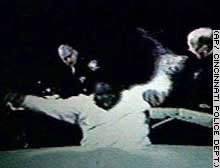

At around 6:00 in the morning of Sunday 30 November 2003, officers from the Cincinnati Police Department (CPD) went to a parking lot next to a White Castle in response to a call that there was a medical emergency. The call had been placed by the Fire Department, which had been brought to the scene first by patrons of the restaurant. In the parking lot, the police officers -- Baron Osterman and James Pike, then three more -- encountered one Nathaniel Jones, a 41-year-old, seriously overweight black man (350 pounds but only 5'9") who was suffering from heart problems excaerbated by use of illegal drugs. No one except the people who were present at the scene know what happened next, that is, what led the police officers -- all but one of whom were white -- to use their clubs and pepper spray to "subdue" Mr Jones, who minutes later died as a result of his injuries.
Without doubt, similar incidents happen all the time in this institutionally racist country. But we know about this incident, because, unlike the others, it was captured on videotape. Ironically, it wasn't a bystander who videotaped the crime, as in the infamous Rodney King incident, but the police themselves. Using a surveillance camera installed on the dashboard of one of their squad cars, the CPD videotaped most of the fatal encounter with Mr Jones. But the CPD didn't wait for a grand jury or any other investigative body to issue a subpeona before they gave out copies of their tape, and they didn't give copies to judges or prosecutors, but news reporters. No: in an obvious attempt to manipulate public opinion, influence potential jurors, justify their officers' clearly inappropriate use of excessive force, and demonize the victim, the CPD released the tape (and details of Mr Jones' criminal record) on their own, as a pre-emptive "first strike."
Significantly, this videotape fails to capture the first minute and a half of the incident. Viewers see the "fight" that ensued, but don't see what preceded it, what caused it. But the CPD didn't erase anything, nor did they withhold any footage. The "gap" in the tape was caused by an accident. The camera typically starts recording when the car's emergency lights are turned on; this means that when the police first showed up at the parking lot, their emergency lights were off or hadn't been turned on. (Either way, when this "incident" began, the police didn't perceive Mr Jones as a threat, neither to himself, bystanders nor the police themselves.) After the violence began, the camera was turned on by an officer at the scene, who thoughtfully used a hand-held device to trigger it.
How's that for a brilliant move? Very thoughtful; almost prescient. Without the first minute and a half, that is to say, without knowing if the big man was provoked or not, there is no choice but to go along with (be unable to refute) the CPD's bullshit: "Nathaniel Jones turned violent, so the officers had to subdue him; his death was caused by his choice to resist arrest, not by the severe beating he received." There is no other evidence, nothing that can possibly contradict the official story.
One can't help wondering if the CPD officer who hit the "record" button knew it was a brilliant move. After all, he might have been making a big mistake by videotaping his fellow police officers while they beat an unarmed man to death. It would obviously be easier to cover the whole thing up (portray the murder as an act of self-defense or even completely unrelated to the conduct of the police) if there was no videotape at all. But surely he remembered what he'd been told: "If there's trouble of any kind, better be 'safe' than sorry, turn the camera on, just in case; and if it turns out that you 'inadvertantly' record something that you shouldn't have, well . . . it's a simple matter for the higher-ups to have your whole tape turn up mutilated, misplaced or missing."
Lots of police cars in America have remote-controlled video cameras installed in their dashboards. According to a survey conducted in April 2001 by The International Association of Chiefs of Police, most American police departments -- though their officers believe that video cameras are ineffective when it comes to preventing, deterring or even detecting criminal activity in public places -- install them in their squad cars and interrogation rooms. In other words, the police generally use cameras where the problem isn't "crime," but lawsuits that allege police brutality, excessive use of force, wrongful death, etc etc. The police don't use their tapes to convict others; they use them to exonerate themselves.
And that's precisely what's been happening this past week in Cincinnati: despite or precisely because of the "accidental" gap, the police are using their surveillance footage to exonerate themselves. This horrific incident isn't an exception to the rule, just as Nathaniel Jones isn't the only unarmed black man who's been killed by the CPD. No: this incident is a perfect example of how video surveillance works, or at least how it works for the police and against everyone else.
-- 2 December 2003.
By e-mail SCP@notbored.org
By snail mail: SCP c/o NOT BORED! POB 1115, Stuyvesant Station, New York City 10009-9998